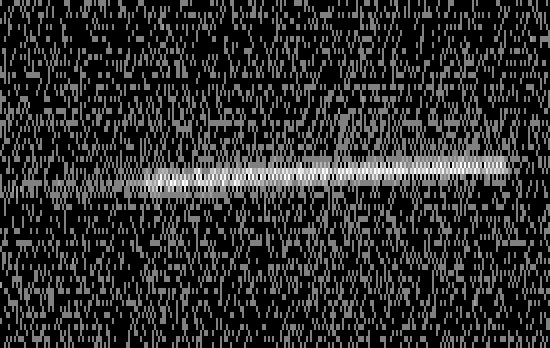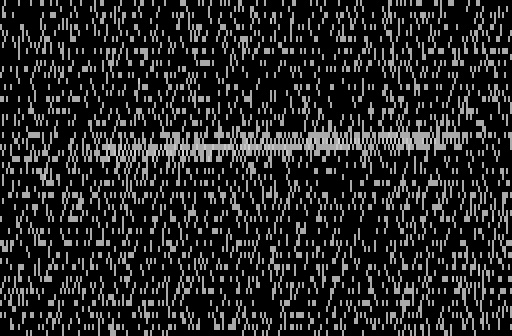I mounted a Leica 135mm f/3.4 APO Telyt on the a7R, mounted the camera on the tripod head with a generic RRS plate (RRS does not at present have custom plates for the a7 or a7R), and made an image (details in the preceding post). Here it is with as 6x expansion vertically and 2x horizontally:
Can’t tell vibration from the ‘scope spot size. I went back, turned the ‘scope intensity down so far I couldn’t see it with the room lights on, refocused the ‘scope, and tried again. Here it is at 6x vertical, 2x horizontal expansion:
Surely not definitive. I think we can say for sure that whatever vibration there is has a peak to peak amplitude of two pixels or less. Maybe a lot less. The only way to find out for sure is get a lot further away from the scope than thirty feet, and I don’t have a practical, repeatable way to do that.
We can make some conservative calculations from the work in the previous post with the 400mm lens. Assuming the vibration is no worse than with the 400, the result on the sensor ought to be roughly a third as large with a 135mm lens because of the ratio of the focal lengths, or about 1.5 pixels peak to peak. There is every reason to think that it is substantially less than that. With a collar-mounted lens, the shutter is some distance from the point at which the tripod attaches — with the 400 it’s more than a foot — and therefore it has a mechanical advantage when it moves that makes the whole assembly swing up and down pivoting on the tripod mount point. When the tripod mounts to the camera through a plate on the camera base, the shutter has to work a lot harder to move the camera/lens combination.
I had hoped to be able to answer the question, “Is the vibration less when using a collar on the lens adapter, or when the camera is attached to the tripod using a plate on the bottom?” I don’t have a sufficiently fine spot to do that. With a perfect lens that has no diffraction, to get a one-pixel spot on the D800E or a7R with a 100mm lens, I need to be 21 meters away from a 1 mm light source. With a 135mm lens, I need to be 29 meters away from a 1 mm light source.
Maybe I could do something with a couple of mirrors. Hmm…


Hello Jim,
What I coincidence!. Today I posted again my results of the shutter vibration test with the A7r. Far less sophisticated than yours of course, but I came exactly to the same conclusion.
No direct worries for native lenses or adapted lenses to 90 mm. Problems occur around 1/30s with longer adapted lenses and where required the use of a tripod collar.
Please see my results here:
http://www.flickr.com/photos/leicasonyzeiss/
With kind regards,
Herb